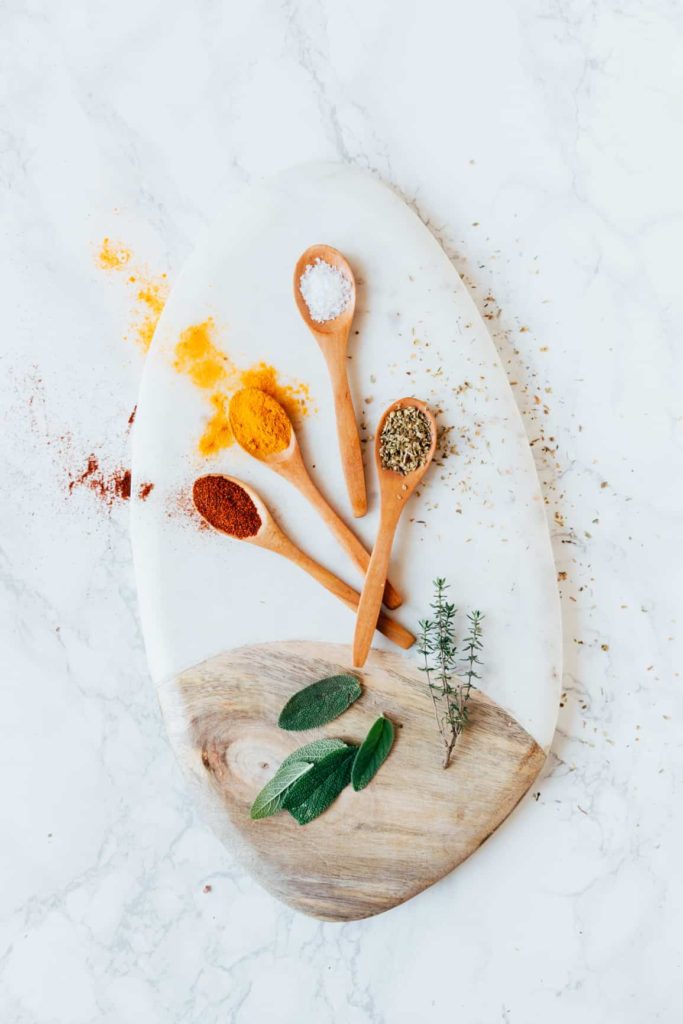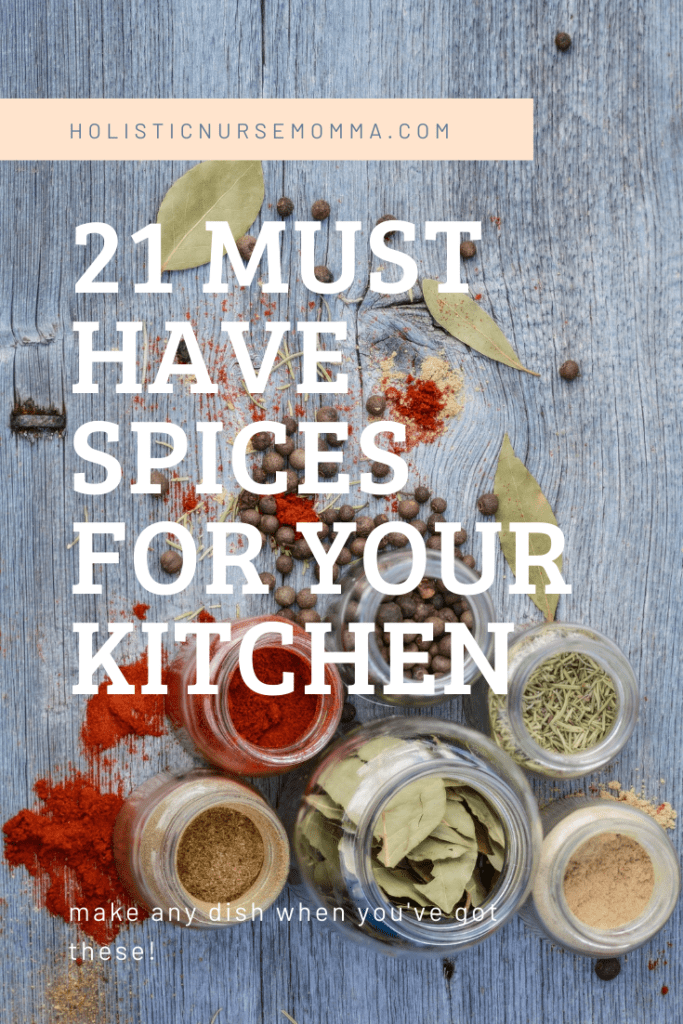Cooking with herbs & spices is a easy way to give your food flavor without the added salt & sugar. They enhance a meal and can turn a food into a completely different dish. When you cook with herbs & spices, you’re also getting the benefit of adding different nutrients to your dishes, thus, added health benefits!
Having a variety of spices & herbs on hand can help you change up your dishes in new ways. As you start to cook with different spices, you’ll probably also notice you begin to pick favorites for certain things.
The Difference Between Herbs & Spices
Herbs and spices are sometimes used interchangeably, but they are different.
Herbs tend to be fresh and you can grow them yourself.
Spices, on the other hand, tend to be dried and can be made from seeds, herbs, barks, roots, etc.
The Basics
Here are some spices to always have on hand. Make sure when you buy these that they are one ingredient (ie the spice itself). You don’t want additives or preservatives in your spices, just as you don’t want them in your food!
Also, keep in mind that if you buy spices from a spice shop, they tend to be fresher and keep longer. Although they’re dried, that doesn’t mean they’ll last forever. Look for expiration dates. Usually, you can still use them past this date, they just won’t be as flavorful. But, as always, do a quick check for each individual spice before using them past an expiration date to ensure they won’t make you sick.
-
Basil
- When fresh (herb/plant), it’s great to use in a homemade pesto, pasta sauces, & soups. I have even used the leaves and put them on grilled avocado-cheese sandwiches.
- When dried (spice) you can use in Italian dishes, soups, and on vegetable dishes. We throw it on veggies before we sauté them or bake them in the oven in a DIY blend.
-
Cayenne Pepper
- If you enjoy spicy dishes, make sure to have this one in your spice cabinet (it’s made from the chili pepper). You can use it for a DIY taco mix, in chilis, Cajun or Korean dishes, or whenever you want a little spicy punch.
- I also use it in tea made with lemon, honey, and cayenne when I’m stuffed up and not feeling so hot…doesn’t taste the best but dang it opens everything up!
-
Cilantro
- I prefer this fresh, but I keep it on hand dried also. To me, it has more flavor (or perhaps it has more the flavor I like) when fresh. I use it in tacos, enchiladas, and homemade salsa. If it’s fresh, it’s also good on salads.
- If you see an Asian dish calling for fresh coriander or Chinese parsley, you can sub fresh cilantro. I have read that coriander and cilantro are the same thing, but when we lived in Germany I found coriander not to be as strong tasting. Maybe it being grown in different climates affected the taste? I dunno.
- Word of caution, if you’ve never had cilantro before, try it. Some people say it tastes soapy..I think it tastes delicious!
-
Cinnamon
- Oh how I LOVE this spice! Especially in the fall and winter. This is a good one if you enjoy baking. It can be put in oatmeal, coffee, apple bakes, granola, and more!
-
Cumin
- I personally prefer this ground, although you can find dried seeds too. When I make Mexican dishes, salsa, or chili, you can bet there’s 1 TBPS or more of cumin in it! I also add it to my hummus or curry dishes.
-
Dill
- If you like to pickle things, this one is good to have (that’s why we have “dill” pickles!) Dill is good on summer squash (zucchini/yellow squash), yogurt-dill sauces (tzatziki for example), or salads.
-
Garlic
- You can find this in a variety of forms. I prefer powdered or freshly minced (you buy the head and then use a garlic press) as it doesn’t add unnecessary salt. This is one of those endless possibility spices. You can add it to grilled foods, Mexican dishes, Italian dishes, baked veggies, chilis, salsa, hummus, and more!
- I’ve even found if I cut off the end, peel the skin, thinly slice a clove (one section of the head), then throw it in my cast iron and brown it on both sides I can eat it by itself. It’s SO good with oven roasted veggies too.
-
Ginger
- You can buy a section of ginger root from the produce section or dried, powered ginger. If you’re a ginger newbie, I’d recommended just grabbing the ginger from the spice section of the store. It has a warm, almost spicy flavor that is excellent in Asian dishes.
- If you slice the actual root and boil it in some water, you can make an herbal tea that works well for nausea and upset stomaches.
-
Nutmeg
- In the fall or when making fall inspired dishes that call for cinnamon, nutmeg is a good addition. A little packs a flavorful, spicy punch, so I’d recommended taste testing as you add it.
-
Onion
- Where there is garlic, there can be onion! Well, for the most part. If I add garlic, you can bet there’s onion there too. Although fresh chopped onion does provide numerous health benefits, it can leave you with a tear in your eye. So opting for onion granules or powder maybe a good idea.
-
Oregano
- I can’t help but always say this in a sing-song voice. Oregano is in SO many dishes, sauces, and dressings. You can find it fresh or dried too. Seriously, you can add this to anything.
-
Paprika!
- I’m not much for hot dishes, so when something calls for chili I tend to sub paprika for it and add a little extra. If you enjoy roasted sweet potatoes, you can add a hair of olive oil and paprika. I also use it in Mexican dishes and chili.
-
Parsley
- This can be found fresh or dried also. It can be added to veggies, soups, bean-balls, hummus, pasta dishes, or salsa.
-
Rosemary
- If you buy this fresh, you can boil it in a soup or sauce then pull it out if you please. I like to buy it dried then throw it on my oven-roasted veggies (you can get that recipe here) or any potato dish. I always feel so fancy when using it!
-
Sea Salt
- Himalayan salt & sea salt tend to have more minerals than traditional iodized table salt.
- I’m a firm believer than most people in the US are deficient in iodine since they aren’t consuming lots of seaweed & other seafood. But, to me, even that isn’t a reason to use table salt as the iodine can degrade & disappear over time (if you’ve ever used iodine to clean your drinking water you can literally see it disappear before your eyes). Of course, talk to your healthcare provider & get you iodine levels tested by a provider who knows how to properly test for iodine.
-
Thyme
- This is also used fresh or dried. I really love it in a good vegetable stew, on my roasted veggies, and usually any dish that I’m using rosemary in.
-
Turmeric
- I’m sure you’ve seen the “golden milk” posts. I buy this dried in a powder form. It’s known for it’s yellowish-orange color & health promoting properties. It has a warm taste & is yummy on veggies, soups, rice, and, if you can sneak it past your hubby, hummus.
Easy to use blends
I asked what spices were must have in my Facebook group. There were some blends mentioned, so I figured I’d mention some here too!
- Spicy Turmeric
- We use this fella to make guacamole and I almost always put it on avocados. It’s a brand called Spice Hunter and we find it at Sprouts (our local health food store).
- Chili Powder
- There are many different types of chili powder. They tend to be more milk than cayenne pepper, so if you substitute cayenne for chili powder in a recipe, you may have more spice than you bargained for (just tellin’ ya from experience!) I’ve used it in chilis, stews, soups, and Mexican inspired dishes.
- Curry Powder
- This is a blend of spices used in Thai or Indian dishes
- Pumpkin Spice
- When I make our granola I will use this. It’s also great in coffee, especially if you like this iced coffee!
Am I missing one of your favorite spices or blends? Let me know below!! And don’t forget to pin this to Pinterest so you can use it later too.
XO Meg


Leave a Reply